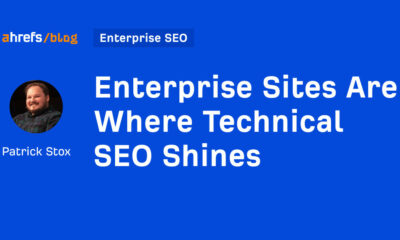SEO
What Large Ecommerce Sites Do Differently

Does it seem harder to attract new customers lately?
Ecommerce is filled with so many incredible opportunities, yet there is so much competition.
The good news – we know it’s possible to thrive!
Large ecommerce sites are doing it – you’ve seen the proof.
Successful, large ecommerce companies approach their SEO in a way that allows them to grow, even with the rising costs of customer acquisition.
Now, you can thrive, too.
On March 9, I moderated a sponsored webinar presented by Jessica Flareau, SEO & Personalization Manager at Barnes & Noble, and Christophe Frenet, Chief Product Officer at Botify.
They provided comprehensive insights for scaling your ecommerce SEO efforts.
Here is a quick summary of the webinar. To access the entire presentation, complete the form.
What Qualifies As A Large Ecommerce Site?
Large ecommerce sites are defined as sites that have more than 1 million URLs.
BN.com has 9 million URLs, while the biggest ecommerce sites in the world have 250 million + URLs.
Since there are so many pages, it’s no longer possible for those large sites to optimize every single page manually.
This means that large ecommerce sites need to automate a great deal more.
This is one task you can start today to help scale your SEO efforts.
[Learn how Barnes & Noble leverages automation for SEO] Instantly access the webinar →
Why Search Engines & Large Sites Struggle
Search engines have to go through hundreds of billions of pages on the web.
Because of limited resources, search engines have to determine how much time they will spend on every single website.
This means that not every page of a large website is noticed nor indexed by search engines.
That’s where crawl budgets come in.
What Is A Crawl Budget?
Crawl budget is the amount of attention your site receives from search bots: how many pages are crawled in a given timeframe.
The bigger your website is, the more chances that the limitations of a crawl budget impact your website.
In short, there is a good chance that your full site may not be crawled by a search bot.
If you have a large number of URLs, your crawl budget may be used up before all your pages are seen.
Crawl Budget Limitations
Based on Botify’s analysis of 6.2B Googlebot requests across 413M web pages, 77% of large website pages are not getting any traffic from search engines.
Why is that?
Search engines have trouble finding every page on your site just because the web is too big.
[Discover how to get the most out of your limited crawl budget] Instantly access the webinar →
How To Balance User Experience & Crawl Budget
To optimize the crawl budget, you need to consider both user experience and bots.
Barnes & Noble recommends working with product engineering to solve this.
Start by:
- Including revenue impact in project requests.
- Educating the team on SEO.
- Implementing automation to manage larger sites.
Barnes & Noble also keeps its sights on revenue impact as it optimizes for search.
[Find out how they do it easily with automation] Instantly access the webinar→
Understanding The SEO Funnel
These days, focusing only on your website’s crawl budget and visibility in search is not enough.
Understanding the SEO funnel will help you optimize your crawl budget and overall scale strategy.
You also need to consider the following as you scale your strategy:
You can probably imagine that this means you have to make a lot of optimizations on your websites.
[Find out how to easily optimize each step] Instantly access the webinar →
How Are Large Ecommcere Companies Handling SEO Scale?
When it comes to smart, scalable SEO foundations and strategies, large ecommerce companies:
- Focus on the top of the funnel. Bigger sites tend to leverage heavier technical SEO at the top of the funnel. This way, these optimizations impact the overall discoverability of the site and act as the foundation of all other SEO initiatives.
- Utilize more technical resources. Larger sites work closely with product engineering to implement optimizations. Large ecommerce companies know that if you want to implement changes without needing vast development resources, automation is vital.
- Use Faceted Navigation. An efficient way to help you and bots navigate and inside a website.
 Botify, March 2022
Botify, March 2022[Find out how Faceted Navigation can help your site] Instantly access the webinar →
Barnes & Noble handles SEO at scale in terms of:
- Managing site performance.
- Faceted navigation.
- Prioritizing pages.
Learn The SEO Strategies For Scale
The following enterprise ecommerce SEO strategies will help you:
 Botify, March 2022
Botify, March 2022[Get the strategy now] Instantly access the on-demand webinar →
SEO Practices Imperative To Ecommerce Success In 2022
- Always invest in fundamentals, such as fixing errors and tracking keywords.
- Keep tabs on site speed and its impact on UX.
- Make sure your content is unique.
[Slides] SEO At Scale: What Large Ecommerce Sites Do Differently
Here’s the presentation:
SEO At Scale: What Large Ecommerce Sites Do Differently from Search Engine Journal
Join Us for Our Next Webinar!
How Much Revenue Are You Losing From Organic Traffic Declines?
What’s the best way to explain loss in organic traffic?
Learn the revenue impact of traffic loss, the key attributes that triggered it, and a way forward to recouping it in our next webinar on March 16 at 2 p.m. ET.
Image Credits
Featured Image: Paulo Bobita/Search Engine Journal
SEO
Google Cautions On Blocking GoogleOther Bot

Google’s Gary Illyes answered a question about the non-search features that the GoogleOther crawler supports, then added a caution about the consequences of blocking GoogleOther.
What Is GoogleOther?
GoogleOther is a generic crawler created by Google for the various purposes that fall outside of those of bots that specialize for Search, Ads, Video, Images, News, Desktop and Mobile. It can be used by internal teams at Google for research and development in relation to various products.
The official description of GoogleOther is:
“GoogleOther is the generic crawler that may be used by various product teams for fetching publicly accessible content from sites. For example, it may be used for one-off crawls for internal research and development.”
Something that may be surprising is that there are actually three kinds of GoogleOther crawlers.
Three Kinds Of GoogleOther Crawlers
- GoogleOther
Generic crawler for public URLs - GoogleOther-Image
Optimized to crawl public image URLs - GoogleOther-Video
Optimized to crawl public video URLs
All three GoogleOther crawlers can be used for research and development purposes. That’s just one purpose that Google publicly acknowledges that all three versions of GoogleOther could be used for.
What Non-Search Features Does GoogleOther Support?
Google doesn’t say what specific non-search features GoogleOther supports, probably because it doesn’t really “support” a specific feature. It exists for research and development crawling which could be in support of a new product or an improvement in a current product, it’s a highly open and generic purpose.
This is the question asked that Gary narrated:
“What non-search features does GoogleOther crawling support?”
Gary Illyes answered:
“This is a very topical question, and I think it is a very good question. Besides what’s in the public I don’t have more to share.
GoogleOther is the generic crawler that may be used by various product teams for fetching publicly accessible content from sites. For example, it may be used for one-off crawls for internal research and development.
Historically Googlebot was used for this, but that kind of makes things murky and less transparent, so we launched GoogleOther so you have better controls over what your site is crawled for.
That said GoogleOther is not tied to a single product, so opting out of GoogleOther crawling might affect a wide range of things across the Google universe; alas, not Search, search is only Googlebot.”
It Might Affect A Wide Range Of Things
Gary is clear that blocking GoogleOther wouldn’t have an affect on Google Search because Googlebot is the crawler used for indexing content. So if blocking any of the three versions of GoogleOther is something a site owner wants to do, then it should be okay to do that without a negative effect on search rankings.
But Gary also cautioned about the outcome that blocking GoogleOther, saying that it would have an effect on other products and services across Google. He didn’t state which other products it could affect nor did he elaborate on the pros or cons of blocking GoogleOther.
Pros And Cons Of Blocking GoogleOther
Whether or not to block GoogleOther doesn’t necessarily have a straightforward answer. There are several considerations to whether doing that makes sense.
Pros
Inclusion in research for a future Google product that’s related to search (maps, shopping, images, a new feature in search) could be useful. It might be helpful to have a site included in that kind of research because it might be used for testing something good for a site and be one of the few sites chosen to test a feature that could increase earnings for a site.
Another consideration is that blocking GoogleOther to save on server resources is not necessarily a valid reason because GoogleOther doesn’t seem to crawl so often that it makes a noticeable impact.
If blocking Google from using site content for AI is a concern then blocking GoogleOther will have no impact on that at all. GoogleOther has nothing to do with crawling for Google Gemini apps or Vertex AI, including any future products that will be used for training associated language models. The bot for that specific use case is Google-Extended.
Cons
On the other hand it might not be helpful to allow GoogleOther if it’s being used to test something related to fighting spam and there’s something the site has to hide.
It’s possible that a site owner might not want to participate if GoogleOther comes crawling for market research or for training machine learning models (for internal purposes) that are unrelated to public-facing products like Gemini and Vertex.
Allowing GoogleOther to crawl a site for unknown purposes is like giving Google a blank check to use your site data in any way they see fit outside of training public-facing LLMs or purposes related to named bots like GoogleBot.
Takeaway
Should you block GoogleOther? It’s a coin toss. There are possible potential benefits but in general there isn’t enough information to make an informed decision.
Listen to the Google SEO Office Hours podcast at the 1:30 minute mark:
Featured Image by Shutterstock/Cast Of Thousands
SEO
AI Search Boosts User Satisfaction

A new study finds that despite concerns about AI in online services, users are more satisfied with search engines and social media platforms than before.
The American Customer Satisfaction Index (ACSI) conducted its annual survey of search and social media users, finding that satisfaction has either held steady or improved.
This comes at a time when major tech companies are heavily investing in AI to enhance their services.
Search Engine Satisfaction Holds Strong
Google, Bing, and other search engines have rapidly integrated AI features into their platforms over the past year. While critics have raised concerns about potential negative impacts, the ACSI study suggests users are responding positively.
Google maintains its position as the most satisfying search engine with an ACSI score of 81, up 1% from last year. Users particularly appreciate its AI-powered features.
Interestingly, Bing and Yahoo! have seen notable improvements in user satisfaction, notching 3% gains to reach scores of 77 and 76, respectively. These are their highest ACSI scores in over a decade, likely due to their AI enhancements launched in 2023.
The study hints at the potential of new AI-enabled search functionality to drive further improvements in the customer experience. Bing has seen its market share improve by small but notable margins, rising from 6.35% in the first quarter of 2023 to 7.87% in Q1 2024.
Customer Experience Improvements
The ACSI study shows improvements across nearly all benchmarks of the customer experience for search engines. Notable areas of improvement include:
- Ease of navigation
- Ease of using the site on different devices
- Loading speed performance and reliability
- Variety of services and information
- Freshness of content
These improvements suggest that AI enhancements positively impact various aspects of the search experience.
Social Media Sees Modest Gains
For the third year in a row, user satisfaction with social media platforms is on the rise, increasing 1% to an ACSI score of 74.
TikTok has emerged as the new industry leader among major sites, edging past YouTube with a score of 78. This underscores the platform’s effective use of AI-driven content recommendations.
Meta’s Facebook and Instagram have also seen significant improvements in user satisfaction, showing 3-point gains. While Facebook remains near the bottom of the industry at 69, Instagram’s score of 76 puts it within striking distance of the leaders.
Challenges Remain
Despite improvements, the study highlights ongoing privacy and advertising challenges for search engines and social media platforms. Privacy ratings for search engines remain relatively low but steady at 79, while social media platforms score even lower at 73.
Advertising experiences emerge as a key differentiator between higher- and lower-satisfaction brands, particularly in social media. New ACSI benchmarks reveal user concerns about advertising content’s trustworthiness and personal relevance.
Why This Matters For SEO Professionals
This study provides an independent perspective on how users are responding to the AI push in online services. For SEO professionals, these findings suggest that:
- AI-enhanced search features resonate with users, potentially changing search behavior and expectations.
- The improving satisfaction with alternative search engines like Bing may lead to a more diverse search landscape.
- The continued importance of factors like content freshness and site performance in user satisfaction aligns with long-standing SEO best practices.
As AI becomes more integrated into our online experiences, SEO strategies may need to adapt to changing user preferences.
Featured Image: kate3155/Shutterstock
SEO
Google To Upgrade All Retailers To New Merchant Center By September

Google has announced plans to transition all retailers to its updated Merchant Center platform by September.
This move will affect e-commerce businesses globally and comes ahead of the holiday shopping season.
The Merchant Center is a tool for online retailers to manage how their products appear across Google’s shopping services.
Key Changes & Features
The new Merchant Center includes several significant updates.
Product Studio
An AI-powered tool for content creation. Google reports that 80% of current users view it as improving efficiency.
This feature allows retailers to generate tailored product assets, animate still images, and modify existing product images to match brand aesthetics.
It also simplifies tasks like background removal and image resolution enhancement.
Centralized Analytics
A new tab consolidating various business insights, including pricing data and competitive analysis tools.
Retailers can access pricing recommendations, competitive visibility reports, and retail-specific search trends, enabling them to make data-driven decisions and capitalize on popular product categories.
Redesigned Navigation
Google claims the new interface is more intuitive and cites increased setup success rates for new merchants.
The platform now offers simplified website verification processes and can pre-populate product information during setup.
Initial User Response
According to Google, early adopters have shown increased engagement with the platform.
The company reports a 25% increase in omnichannel merchants adding product offers in the new system. However, these figures have yet to be independently verified.
Jeff Harrell, Google’s Senior Director of Merchant Shopping, states in an announcement:
“We’ve seen a significant increase in retention and engagement among existing online merchants who have moved to the new Merchant Center.”
Potential Challenges and Support
While Google emphasizes the upgrade’s benefits, some retailers, particularly those comfortable with the current version, may face challenges adapting to the new system.
The upgrade’s mandatory nature could raise concerns among users who prefer the existing interface or have integrated workflows based on the current system.
To address these concerns, Google has stated that it will provide resources and support to help with the transition. This includes tutorial videos, detailed documentation, and access to customer support teams for troubleshooting.
Industry Context
This update comes as e-commerce platforms evolve, with major players like Amazon and Shopify enhancing their seller tools. Google’s move is part of broader efforts to maintain competitiveness in the e-commerce services sector.
The upgrade could impact consumers by improving product listings and providing more accurate information across Google’s shopping services.
For the e-commerce industry as a whole, it signals a continued push towards AI-driven tools and data-centric decision-making.
Transition Timeline
Google states that retailers will be automatically upgraded by September if they still need to transition.
The company advises users to familiarize themselves with the new features before the busy holiday shopping period.
Featured Image: BestForBest/Shutterstock
-

 SEARCHENGINES5 days ago
SEARCHENGINES5 days agoBillions Of Google goo.gl URLs To 404 In The Future
-
SEARCHENGINES4 days ago
Daily Search Forum Recap: July 22, 2024
-

 SEARCHENGINES7 days ago
SEARCHENGINES7 days agoGoogle Core Update Coming, Ranking Volatility, Bye Search Notes, AI Overviews, Ads & More
-

 SEO5 days ago
SEO5 days ago11 Copyscape Alternatives To Check Plagiarism
-

 SEO6 days ago
SEO6 days agoGoogle Warns Of Last Chance To Export Notes Search Data
-
SEARCHENGINES3 days ago
Daily Search Forum Recap: July 23, 2024
-

 AFFILIATE MARKETING6 days ago
AFFILIATE MARKETING6 days agoThe Top 5 AI Tools That Can Revolutionize Your Workflow and Boost Productivity
-

 SEO4 days ago
SEO4 days agoSystem Builders – How AI Changes The Work Of SEO
















You must be logged in to post a comment Login